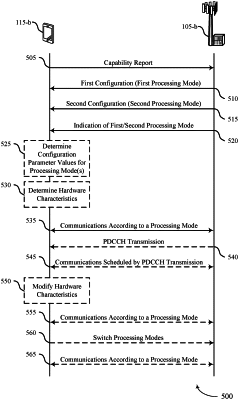| CPC H04W 72/12 (2013.01) [H04W 8/24 (2013.01); H04W 72/20 (2023.01)] | 30 Claims |

|
1. A method for wireless communications at a user equipment (UE), comprising:
transmitting, to a network entity, a capability report indicating a capability of the UE to support multi-transmission time interval scheduling, the capability report comprising an indication of a quantity of control channel monitoring occasions within a scheduling interval for multi-transmission time interval scheduling;
receiving, from the network entity based at least in part on the capability report, a first configuration of a first processing mode for the UE that is associated with communications scheduled for a single transmission time interval, and a second configuration of a second processing mode for the UE that is associated with communications scheduled for the scheduling interval spanning a plurality of transmission time intervals, wherein the second configuration indicates that the UE is to monitor a first quantity of control channel monitoring occasions within the scheduling interval based at least in part on the indication of the quantity of control channel monitoring occasions within the scheduling interval;
receiving, from the network entity, an indication to apply the first processing mode or the second processing mode; and
communicating with the network entity based at least in part on the indication.
|